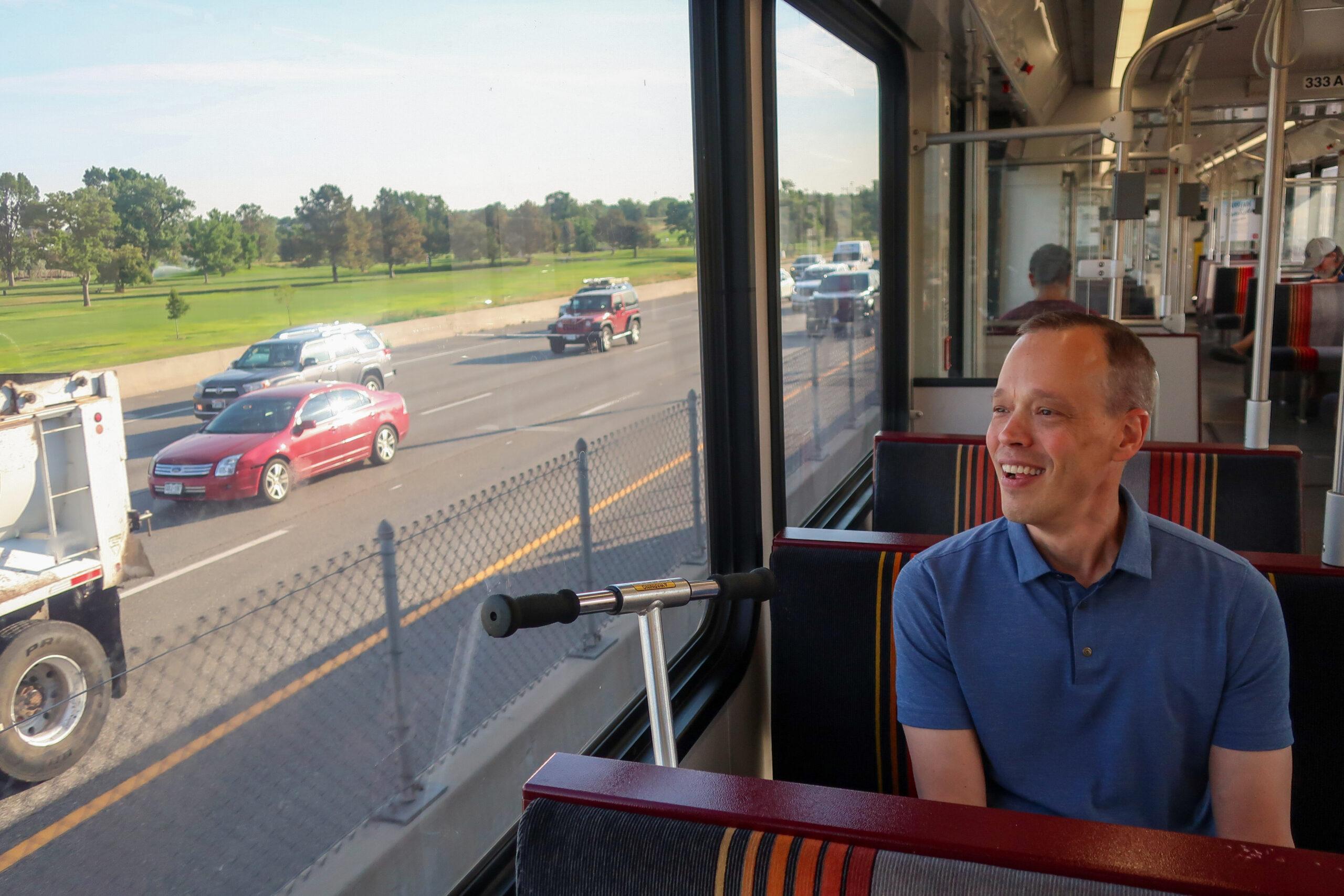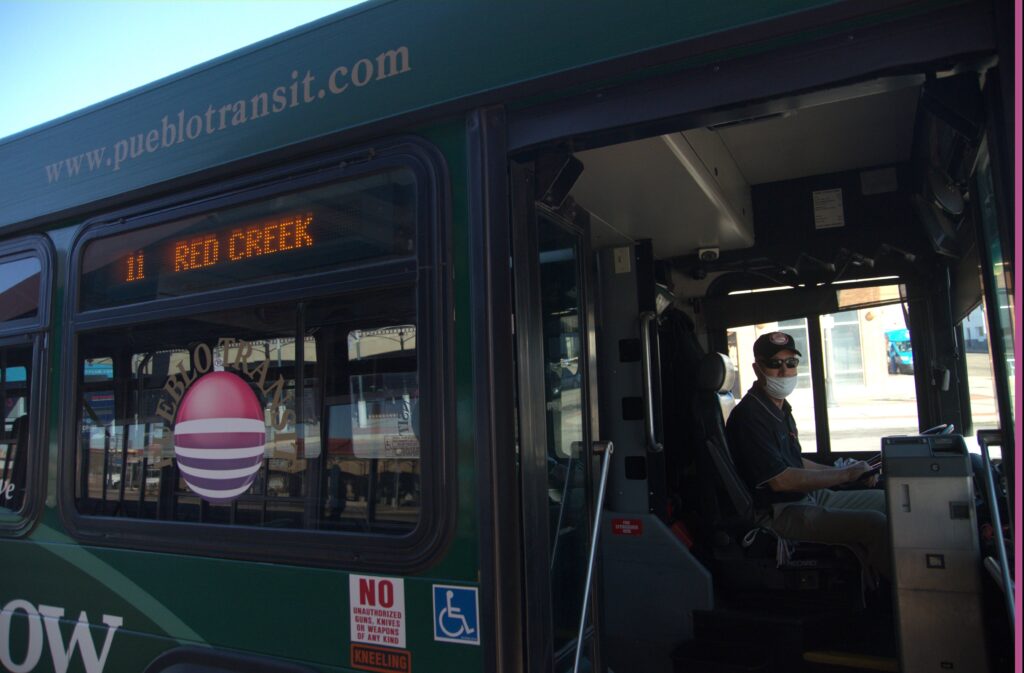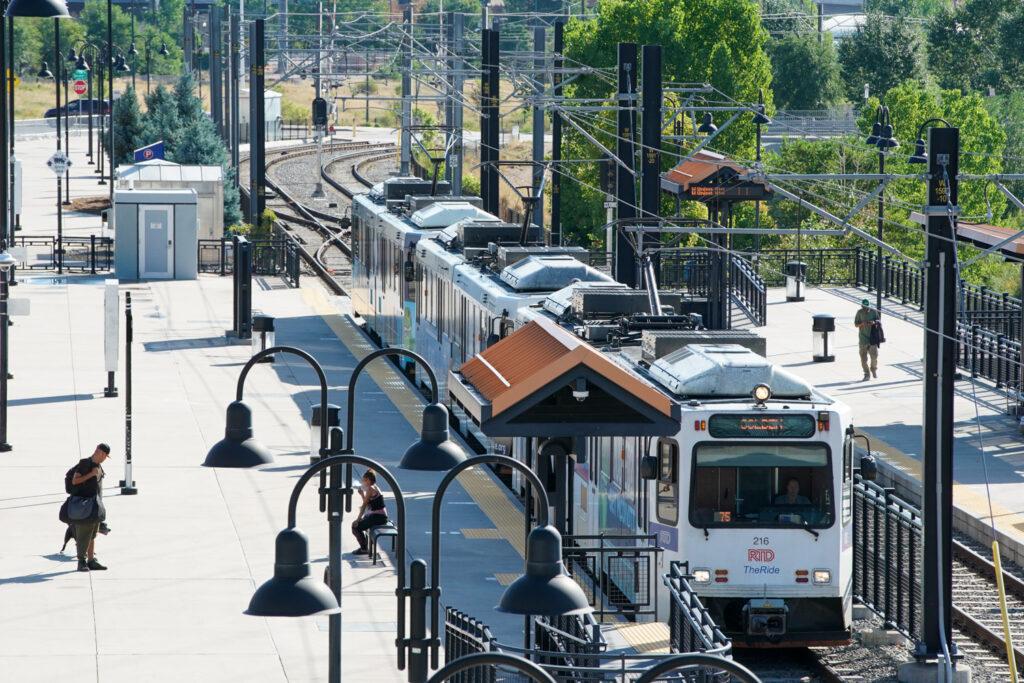
David Bledsoe smiled with glee as the Regional Transportation District R Line train whizzed by highway traffic.
Beldsoe’s ride was back on Aug. 1, the first day RTD and other public transit agencies across Colorado waived fares as part of a state government push to reduce air pollution from vehicle traffic. Door-to-door time via transit was longer than Bledsoe’s typical drive, but he looked forward to the relaxing ride and wanted to do his part to clear the air during ozone-heavy summer days.
Now, a month later, Bledsoe said he’s commuted via RTD about 10 times for free. That’s a big jump for the resident of Denver’s Central Park neighborhood who used to drive to work exclusively. But it was far less than he had hoped at the beginning of the month.
“Convenience is probably the biggest issue,” Bledsoe said. “That was the thing that got in the way of using the light rail more often.”
He’s glad to know that RTD is a viable option, if not always practical. Even with traffic headaches, driving was often easier for Bledsoe when severe weather was in the forecast or when he had to pick up kids after work.
We don’t yet know how many commuters like David Bledsoe are out there or what their impact was
A spokesperson for RTD, the state’s largest transit agency, said it will publish a report on ridership during the free-fare month in November. But anecdotally, it appears buses and trains were running a bit fuller in August than earlier in the pandemic when they were largely empty.
“It feels nice seeing more people on the train,” said Madeline Goldkamp one morning last week from her seat on a mostly full W Line. “Because often I’ll get toward the end [of the line] and there’s barely anyone. And it’s kind of creepy to be honest.”
Ron Short, vice president of the ATU Local 1001, has been driving buses for RTD for more than 20 years. To his eyes, ridership has risen between 5 percent and 7 percent in the last month.
“It's having the desired effects as far as people coming out, people trying the service,” he said. “It really has.”
Smaller transit agencies around the state saw significant jumps in ridership through the first three-plus weeks of August, said Ann Rajewski, executive director of the Colorado Association of Transit Agencies. Those year-over-year increases include a roughly 60 percent rise in Pueblo, 48 percent in Colorado Springs, 35 percent in Fountain, and 28 percent in Bent County.
“It’s exciting to see,” Rajewski said.
It's unclear how many of the new rides were taken by existing transit users riding more frequently or, as state officials would like, drivers switching to transit. Rajewski said a more detailed report covering non-RTD agencies is expected by the end of September.
Pueblo transit director Ben Valdez said they’ve seen a “whole lot of new ridership.”
"My operators have been driving the same routes for like a thousand years,” Valdez said. “So they see the same people every day and they're telling me about all the new faces they got going on."
The Colorado Department of Transportation’s statewide Bustang service, which has been offering half-price fares since July 1, has seen ridership climb 63 percent compared to the same period last year. The West Line between Denver and Grand Junction is now even carrying more people than it did in 2019 before the pandemic, CDOT data show.
A spokesperson for Gov. Jared Polis said ridership data will be helpful for the state in future planning. Polis told CPR’s Colorado Matters in early August that the state may expand the program in coming years; it is already set to return in August 2023.

The free fare programs’ impact on air quality is also still quite fuzzy
Spokespersons for the state health department and the Regional Air Quality Council said they don’t have enough information to analyze the program’s impact on air quality — yet.
“We’re excited to see ridership numbers from participating transit agencies across the Front Range,” the air council’s David Sabados wrote in an email. “Every trip on a bus or train that could have been a car trip is beneficial for our air quality.”
So far this ozone season — typically June through August — the state has recorded 25 fewer action alert days than last year. But Leah Schleifer with the state health department said “many different factors” can account for that beyond driving, like weather patterns and other pollution sources.
Overall, the effort’s immediate effect on air pollution will likely be small because of how dominant cars are across Colorado. Only 4 percent of commuters in the sprawling, car-centric Denver metro use transit, according to Census data; more than 70 percent drive alone. Even a doubling of transit riders would only move the needle a little bit because there aren't that many to begin with.
Denver’s been in a similar position before. A year-long free-fare experiment from the late 1970s shifted some 12,000 drivers to RTD buses, but the resulting reduction in overall driving was just one-half of 1 percent. Denver’s “brown cloud” of the era only dissipated after the federal government raised vehicles’ emission standards.
A similar dynamic may play out now with ground-level ozone. The state, as part of its climate efforts, is incentivizing drivers like David Bledsoe to move to electric vehicles — and he said he’s considering it.
“I'll probably be taking action much sooner than I thought I would, to try to reduce my own impact,” he said.
The free fare program was never meant to “fix everything,” said Sen. Faith Winter, D-Westminster, who sponsored the legislation that created it. Rather, she hopes the program will help further the state’s gradual push to bolster public transportation across Colorado.
“You don't change culture overnight, and you don't build transformative systems overnight. Those take time to build and change and this was a significant step forward,” she said, adding: “We’re not going to meet our climate goals without reducing our vehicle miles traveled.”

More than free rides, some passengers just want reliable service — and more of it
Megan Henderson was holding onto her bicycle as she rode the W Line to her job at Denver Health. It helps her get to the station faster — and it came in handy recently when her return train never showed up after 30 minutes of waiting.
“I grabbed my bike and rode an hour home,” she said, adding: “[RTD] has to be reliable enough for people to utilize it on an ongoing basis.”
RTD’s ongoing driver shortage and long-term funding challenges are two big reasons for service being unreliable and infrequent in many places. And while the state government has footed most of the bill for free fare month, it’s been hesitant to give RTD new funding directly.
A multi-billion-dollar transportation funding bill Democrats passed last year will raise hundreds of millions of dollars for transit statewide, but it did not include any dedicated funding for RTD. The agency is eligible for state grants through that bill, but an RTD spokeswoman said the agency has not applied for any and has not received any money from it yet.
A state climate rule could also shift nearly a billion dollars toward clean transportation — including public transit projects — in the Denver area, but none of that appears to be heading toward RTD’s operations budget either.
A coalition of environmental, labor, disability, and transportation safety groups is organizing to change that dynamic. The new “Alliance to Transform Transportation,” announced Wednesday, is exploring different ways to raise more money to fund a higher level of transit service — perhaps through RTD, perhaps not. Funding options include a ballot initiative to raise sales taxes and persuading legislators to allocate more state money to public buses and trains in the Denver area.
“RTD gets less than 1 percent of their operating budget from the state,” said Molly McKinley, policy director for the Denver Streets Partnership. “We know that the state can't just manufacture new dollars. But we certainly want to start exploring options for what that could look like.”
State legislators and the governor's office have yet to start the budget process, but Winter said she'll support the state's continued investment in public transit.









